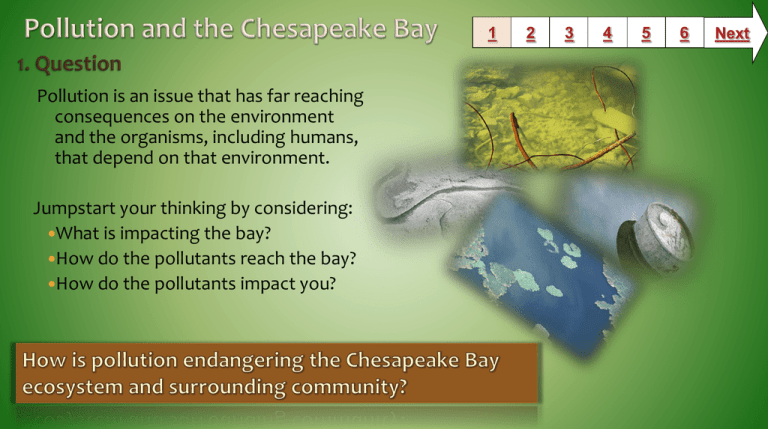
1
Pollution is an issue that has far reaching
consequences on the environment
and the organisms, including humans,
that depend on that environment.
Jumpstart your thinking by considering:
What is impacting the bay?
How do the pollutants reach the bay?
How do the pollutants impact you?
2
3
4
5
6
Next
1
Here are some web based resources to enhance your
knowledge about pollution and the importance of the
Chesapeake Bay:
Introduction:
• Watch Pollution
• Read General Bay Info
• Read Why the Bay Matters
Pressure on the Bay:
Read about different pollutants
Click here for read aloud access
Pollutant Types:
Nutrient | Sediment | Chemical | Air
Read about the land and people
Click here for read aloud access
Image Galleries – be sure to cite your photos!
• Pollution
• Land and People
www.airnow.gov
2
3
4
5
6
Next
1
2
3
4
5
6
A. Select a topic from the Air & Water Pollution list
Nutrient
Sediment
Chemical Substances
Air
B. Research the topic you selected using the Information
Sources.
C. Record your responses in the
Air and Water Pollution Types chart
D. When you have completed the graphic organizer, choose
a topic from the Land & People list that relates to your
pollutant and research using the Information Sources :
Population growth
Development
Impervious surfaces
Storm water
Land use
Transportation
E. Use a graphic organizer to record your findings.
When recording the effect and solution consider the
human and environmental factors.
Map courtesy of Chesapeake Bay Foundation
Next
1
You will create a visual presentation for
your Assessment Activity.
2
3
4
5
6
Next
How can you visually communicate the effect
air and water pollution have on the land and
it’s inhabitants?
www.clipart.com
1
2
3
4
5
6
Additional resources to enhance your
knowledge of pollution:
Login as a guest and explore Bayville
Stream Cleaner Activity
Chesapeake Bay Puzzle
The Great Pacific Garbage Patch
Huge Atlantic Garbage Patch
Extension
Our Schoolyard Ecosystem
Use a flip- cam in order to document instances of
water/air pollution in your school habitat.
Next
1
BCPS Curriculum
O-15 Using charts, photographs, and diagrams, the student will recognize and describe
that environmental changes can have local, regional, and global consequences.
KSI-A Identify and describe a local, regional, or global environmental issue.
KSI-B Describe how natural processes change the environment.
KSI-C Identify and describe how human activities produce changes in natural processes.
KSI-D Recognize and explain the impact of a changing human population on the use of
natural resources and on environmental quality.
Maryland State Curriculum
Standard 6.0 Environmental Science: Students will use scientific skills and processes
to explain the interactions of environmental factors (living and non-living) and
analyze their impact from a local to a global perspective.
Common Core State Standards
Reading: 1. Read closely to determine what the text says explicitly and to make
logical inferences from it; cite specific textual evidence when writing or speaking to
support conclusions drawn from the text.
Writing: 7. Conduct short as well as more sustained research projects based on
focused questions, demonstrating understanding of the subject under investigation.
Standards for the 21st Century Learner
1.1.6 Read, view, and listen for information presented in any format (e.g. textual,
visual, media, digital) in order to make inferences and gather meaning.
2.1.3 Use strategies to draw conclusions from information and apply knowledge to
curricular areas, real-world situations, and further investigations.
Maryland Technology Literacy Standards for Students
3.0 : Use a variety of technologies for learning and collaboration.
2
3
4
5
6
Time Frame:
Two forty-five minute class periods
Differentiation:
Direct students to use comprehension tools included in databases,
such as: audio read-aloud, labeled reading levels, and embedded
dictionaries.
Learning Styles:
Field Dependent | Field Independent |Global Understanding | Analytical
Understanding | Active | Reflective | Visual | Auditory | Tactile
AVID Strategies:
Inquiry Based Learning
Graphic Organizers
Costa’s questioning
Gallery Walk for Assessment
Notes to the teacher:
Consult with your School Library Media Specialist to implement
this Slam Dunk Lesson.
Animot o requires an login to access. Consult your School Library
Media Specialist for assistance.
Students can turn in activities by saving Microsoft documents and
copying it to a teacher or student drop folder.
If a computer lab is not available, this lesson may be implemented
in the classroom or library using an interactive whiteboard or
printouts of the linked digital resources.
Last update: July 2011
Created by Laura A. Vandenberge , updated by Melyssa Kenney
BCPS Research Module or Slam Dunk Model, Copyright 2005, Baltimore County Public Schools, MD, all rights reserved. The models may be used for educational, non-profit school use
only. All other uses, transmissions, and duplications are prohibited unless permission is granted expressly. This lesson is based on Jamie McKenzie’s Slam Dunk Lesson module available
at http://questioning.org/module2/quick.html.


